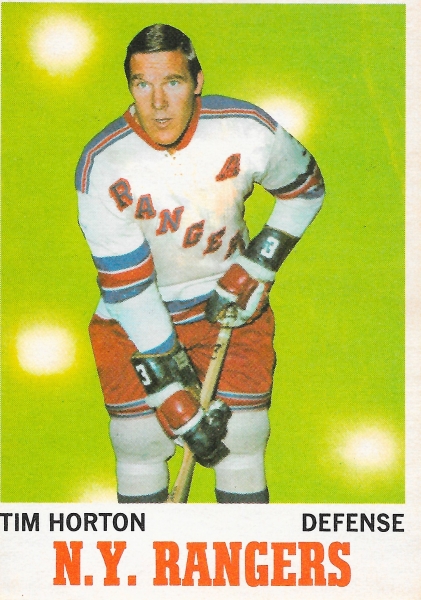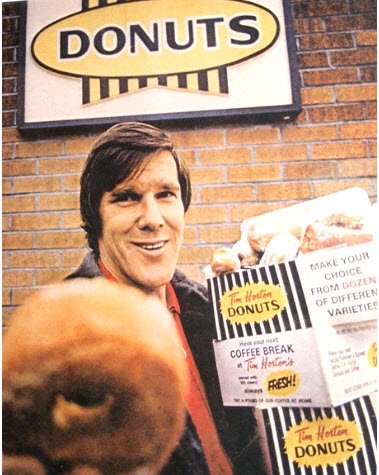Tim Horton Was Hockey’s Strongest Man Before He Was Hockey’s Strongest Brand

Contents
With the delay of Upper Deck Series 1 Hockey until January, more collectors than ever have been filling their thirst for collecting hockey cards with the 2021-22 Upper Deck Tim Hortons hockey promotion.
The annual set has dropped the puck on the NHL collecting season for the past several years. Packs of three cards were available for 99 cents with a drink, or $1.99 per pack on their own. Each pack featured two micro-etched foil base cards and a red variation or insert.
The set is only available in Canada and was supported with a national TV and radio campaign, giving the hobby more mainstream exposure than any other promotion in North America.
While collectors and hockey fans in the United States have scoured eBay for packs, sets and singles, they may ask the age-old American hockey question when they pull card number 1.
Who Was Tim Horton?
“Tim Horton is a hockey icon in Canada, and we feel it is important to include him in the set, and to have him as card number one,” said Upper Deck brand manager Paul Zickler in an interview earlier this year. “Tim Hortons has become synonymous with hockey in Canada.”
Older collectors and hockey fans from the original six era and early expansion know all about Horton. He was one of the NHL’s premier defensemen in the 1960s. He was a big part of the 1966-67 Toronto Maple Leafs Stanley Cup championship team, the last Leafs team to win the Cup.
Horton was born in the northern Ontario mining town of Cochrane, Ontario in 1930. His father was a railway mechanic. Tim excelled as a hockey player, dominating junior hockey in northern Ontario with his strength and skating ability. He moved south to Toronto in the 1947-48 season to go to school and play junior hockey for the Toronto St. Michael’s Majors.
He signed with the Leafs, and played one game in each of the 1949-50 and 1951-52 seasons while toiling in the AHL with the Pittsburgh Hornets. He would crack the Leafs line-up in the 1952-53 season.
Hockey’s Strong Man

“When I look back at the toughest guys to play against, there were a few that really stand out for different reasons, Gordie Howe told me in a 1994 interview. “But Tim Horton was really difficult to play against. He was, pound-for-pound, the strongest player I faced in my entire career.”
Horton’s strength was legendary. Between his summers working construction and his intense workouts – during an era when players did not routinely work out – Horton was thick, wide, and incredibly strong for a man who stood 5’10” and weighed 180 pounds.
“I was pretty successful in the corners and in puck battles,” Howe said. “But Tim Horton was stronger than the other players and he had a low center of gravity that made it difficult to move him. He won almost every puck battle he had in his career.”

Howe, who stood 6’3” and was known for his elbows as much as his strength.
“Guys like Horton and Leo Boivin played lower to the ice and you could not get a good shot at them,” he said. “The thing with Tim Horton is that he played an extremely clean game. He was not mean or vicious, and he didn’t use his stick on guys or take cheap shots. He was always in position. The one thing he did better than anyone I played against was that he was on you as soon as you had the puck. You never had any time or space against him. And he was so strong, you couldn’t go through him.”
Howe, as tough as he was talented, said he did not recall Horton ever getting in a fight.
“If you got into a battle in the corner with him, he would put you in a bear hug,” Howe said. “And if you got under his skin, you would feel like your ribs were about to crack. But he rarely fought, if ever. He was so strong that no one really wanted to take a chance and mix it up with him.”
Coffee Shop Idea
Both the Red Wings and Maple Leafs players were very underpaid in the days before free agency and a players union. The man who made many of the Maple Leafs financially successful was Bobby Baun, a teammate of Horton’s.
“I started out by selling cars while I was still in high school,” Baun said at a chat at an Ottawa Senators-Toronto Maple Leafs game about five years ago. “As the years went on, I became very interested in the stock market and what happening on Bay Street. I started investing the money I made playing hockey and did very well. Before long, I was helping a lot of guys on the team with their investments.”

Baun, like Horton, was a hard hitting, well-coached, clean player. He was tough as nails. Baun and Horton were on Maple Leafs teams that won four Stanley Cups in the 1960s. In 1964, Baun scored the Stanley Cup-winning goal in overtime against the Detroit Red Wings while playing on a fractured leg.
Horton had long discussions with Baun about his idea for a coffee and donut shop. Baun became an investor. Horton would join forces with Montreal businessman Jim Charade to open the first Tim Hortons shop, which was located in Hamilton, southwest of Toronto. Horton and Charade formed Timanjim, Ltd. In 1963, they opened four restaurants in the Toronto area called Tim Horton Drive-Thru and sold burgers and chicken. Charade, who had been the manager of a doughnut factory, opened a store called Your Do-Nut. Charade would license Horton’s name, and he turned the store into Tim Horton Do-Nut.
The first Tim Hortons franchise store was opened in 1964 in Hamilton, about a half hour drive on the QEW southwest of Toronto. The franchisee was a 21-year-old bank clerk named Spencer Brown. The shop opened a month after Baun’s Cup-winning goal.

The first Tim Hortons shop in Hamilton, ONT in the 1960s. Wikipedia photo.
“I had one condition,” Baun explained. “I wanted there to be a drive thru. Nobody was doing that at the time, and I thought that would make us successful right away.”
He was right. Tim Horton’s exploded within a few years, with franchises popping up throughout Ontario and then all over Canada. It is interesting to note that Tim Horton’s eventually became Tim Hortons without an apostrophe to appease language laws in Quebec.

Tim Horton and his donuts.
Like Horton, Baun had a long career. His ended at the age of 36 early in the 1972-73 season. Baun had his neck cut by a skate and was also playing on a broken leg. Horton found his friend and teammate outside the team bus, picked him up in his arms, and carried him to the hospital. His wife happened to be in the same hospital. Baun was given blood, and when he stabilized, he was brought to a bed next to his wife, who was giving birth to their third child.
Baun, like Howe and every other player from that era, remembers Horton for his strength.
“Off the ice, he had to wear these thick glasses,” Baun recalled. “We called him Clark Kent. One time we were in Montreal and as a prank he caused a traffic jam by lifting barrels of cement and carrying them over to block an intersection. Nobody else in the NHL could have done that.”
Horton Killed After Game
After a long run with the Leafs, Horton would play for the New York Rangers, Pittsburgh Penguins and then the Buffalo Sabres. A remarkable physical specimen, he was still one of the NHL’s best defensemen in his 40s. Only Chris Chelios and Zdeno Chara have been as dominant in their 40s as Horton was.
After a game in Toronto, Horton, 44, was driving home to Buffalo in his sports car. Going through St. Catharines, which is about halfway between the cities, he lost control of his car on the QEW highway and hit the median of the Lake Street underpass. His car rolled, and Horton, who was not wearing a seatbelt, was thrown from the car and found more than 100 feet from where the car ended up, upside down, in the Toronto-bound lanes.
It was later revealed that Horton had stopped in Oakville, just southwest of Toronto, to go to his office to meet business partner Ron Joyce. Horton had been drinking. Both Joyce and Horton’s brother Gerry, whom he had been talking to by phone, urged him not to drive home.
After the funeral, Joyce offered Horton’s widow, Lori, $1 million for her shares in the company as well as the 40 stores he owned. She accepted the offer.
It was a tragic loss for hockey, as Horton was a beloved NHL player. Canada had also lost an icon, as by the time of his death, as many people knew Tim Horton for his donut and coffee shops as they did for being an NHL All-Star.
Tim Hortons And Hockey
Tim Hortons has grown into Canada’s largest quick service restaurant chain. In 1995, Wendy’s bought Tim Hortons and owned the company for 11 years. In 2014, Brazilian Equity company 3G Capital purchased the company. Despite the foreign ownership, Tim Hortons remained synonymous with Canadian culture, youth sports, and in particular, hockey.
In addition to sponsorships with various NHL teams in Canadian and selected U.S.-based teams close to the border, Tim Hortons continued to grow their sponsorships of youth sports in Canada. Timbits Hockey, which is Canada’s initiation hockey program for players under the age of seven, helps brand the company with grass roots hockey in cities and small towns across the country.

Tim Hortons would eventually wrestle away the deal to become the NHL’s Official Quick Service Restaurant in Canada. McDonald’s was the NHL’s QSR partner in Canada for decades. With the deal came the right to produce the annual NHL hockey card set that was part of the deal. Upper Deck, Pinnacle and Pacific had produced the McDonald’s hockey card sets in Canada for more than a decade. When Tim Hortons got the deal, Upper Deck had an exclusive trading card license with the NHL and NHLPA. The partnership for an Upper Deck Tim Hortons hockey card set was a perfect fit. Sidney Crosby and Nathan MacKinnon, both Timbits Hockey graduates, have been the spokesmen for the program for the past several years.
In nearly 60 years, Tim Hortons has been through highs, lows, corporate drama and some ugly in-fighting. But through the generations, Tim Hortons is perhaps the most Canadian of all Canadian brands. As every hockey-playing five and six year old wears the Timbits jersey while moms and dads sit in the bleachers in cold rinks across Canada sipping on their Tim Hortons double-doubles, nothing would probably make Tim Horton prouder than the evolution of his legacy.
And now you know why Tim Horton is card number one in the Upper Deck Tim Hortons hockey card set each year.





